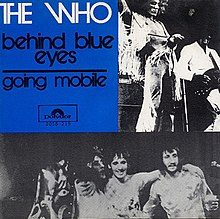Going Mobile
| "Going Mobile" | ||||||||||||
|---|---|---|---|---|---|---|---|---|---|---|---|---|
 |
||||||||||||
| Single by The Who | ||||||||||||
| from the album Who's Next | ||||||||||||
| A-side | "Behind Blue Eyes" (Europe) | |||||||||||
| Released | 6 November 1971 | |||||||||||
| Format | 7" | |||||||||||
| Recorded | May 1971, Olympic Studios, London | |||||||||||
| Genre | Rock | |||||||||||
| Length | 3:43 | |||||||||||
| Label | Decca, MCA, Track, Polydor | |||||||||||
| Writer(s) | Pete Townshend | |||||||||||
| Producer(s) | The Who, Glyn Johns | |||||||||||
| The Who singles chronology | ||||||||||||
|
||||||||||||
|
||||||||||||
| 9 tracks |
|---|
|
"Going Mobile" is a song written by Pete Townshend and originally released by The Who on their 1971 album Who's Next. It was originally written for Townshend's abandoned Lifehouse project, with lyrics celebrating the joy of having a mobile home and being able to travel the open road. The Who's lead singer Roger Daltrey did not take part in the recording of the song, leaving the rest of the band to record it as a power trio; Townshend handles the lead vocals, guitars, and synthesizers, with John Entwistle on bass and Keith Moon on drums. The song has attracted mixed reviews from music critics.
"Going Mobile" is one of the lighter moments on Who's Next. It was originally conceived as part of Townshend's abandoned Lifehouse project. Townshend described the use of the song in the proposed project as follows: "As the story unfolded, because of the vagaries of the modern world, because of pollution being caused mainly by people's need to travel, to be somewhere else. (People) had been told, 'You can't do that anymore. You have to stay where you are.' But people have got this lust for life, and adventure, and a bit of color." It celebrates the joys of having a mobile home and being able to travel the highways at will – Townshend himself had acquired a mobile home about a year before the song was recorded. An example of the theme is illustrated by such lyrics as:
"Going Mobile" was recorded without Who lead singer Roger Daltrey. Rather, guitarist and songwriter Townshend handled the vocals on the song. Instrumentation includes acoustic guitar, bass guitar and drums. A VCS 3 synthesizer is also overdubbed on part of the song. Further, on his guitar solo, Townshend plays the instrument through an envelope follower, a feature of the ARP synthesizer that produces what Townshend describes as a "fuzzy wah-wah sound". Author Chris Charlesworth describes the effect as being as if Townshend is playing underwater. Allmusic critic Tom Maginnis describes Entwistle's bass playing on the song as "ultra-fluid" and Moon's drumming as "exuberant."
...
Wikipedia
